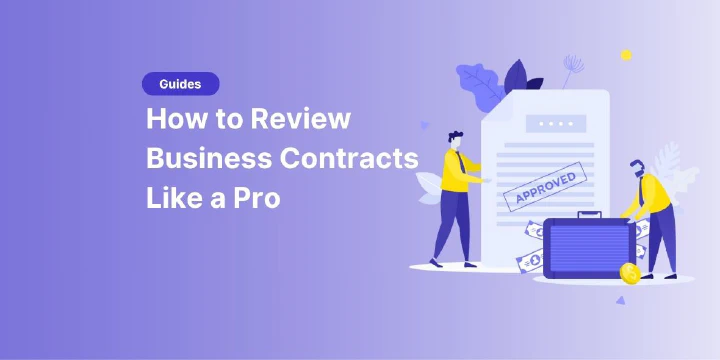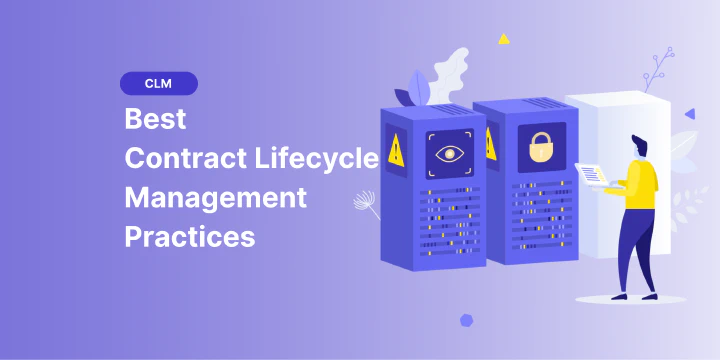Contract Management Process: how the optimal process looks like
The contract management process is the foundation of every contract and therefore critical to successful contractual relationships. Streamlining the workflow of this normally time-consuming process comes with significant benefits.

What is contract management?
Contracts govern a company’s relationships with vendors, customers, partners and employees. Effective contract management ensures that these relationships are efficient and profitable for all parties involved. It covers every step of a contract, from creation to approval, implementation, use, and expiration. A well-established contract management process is therefore critical for any organization.
The best processes leverage contract data throughout the contract lifecycle to improve an organization’s ability to manage financial or legal risk. A dedicated software streamlines the process of managing all contracts that affect an organization, from internal agreements with employees to external commitments with partners and vendors.
What is the contract management process?
Contract management touches every business and operational area of an organization. A consistent and efficient process drives and streamlines the management of each contract through all phases, from creation, negotiation of terms and approval, to execution, performance and adherence to deliverables and deadlines.
Why is the contract management process so important?
The contract management process often does not receive as much attention as other processes in organizations. However, it is an essential factor in effective business process management. An effective process is linked to the overall performance and effectiveness of an organization. It also plays an important role in the company’s relationships with all external stakeholders.
An effective contract management process can help companies:
- Reduce costs and increase profits
- Improve negotiations through contract data analysis
- Improve supplier relationships through data transparency
- Ensure that all contractual obligations of the company and its third parties are met
- Reduce existing procurement, financial and legal risks
- Easily create policies and contingencies to mitigate risks
- Accelerate and improve the overall process
- Establish centralized management system to link contract data with other key processes across the enterprise
- Reducing the need for legal department oversight and intervention in the creation of contracts
What is the optimal contract management process?
1. Preparation
The first step of the contract management process is also one of the most important. This is because a contract is a legally binding document and therefore must be well researched and carefully prepared. If a contract is not prepared, it will affect relations with third parties, and in the worst case, the other party could sue you. It is therefore important to ensure that the contracting parties benefit from each other. It is also important to ensure that all the expectations of the parties are met.
When drafting a contract, the contract manager must consider the following points:
- Complete and accurate information about all parties involved
- The needs and expected outcomes of all parties
- Possible methods for eliminating risks
2. Drafting
The legal drafting of a contract is essential to the contract management process. Working with the organization’s legal team will ensure that each agreement complies with local and international laws. There are often pre-approved templates created by legal experts. This simplifies the contract drafting process and ensures that the contract is compliant with the law.
3. Negotiation
Contract negotiation is the right time to resolve disagreements and misunderstandings before the contract is signed. It is also a place where the parties can make desired changes for mutual benefit and strengthen cooperation.
4. approval
Once all parties have reached an agreement, the contract must be approved by all parties. Often, this step of the contract management process is mapped using digital approval processes through software. Contracts undergo a final review to ensure that they are legally correct, compliant, and in compliance with company standards and policies.
5. execution
In the penultimate step of a classic contract management process, after review and approval, all parties involved can now sign the contract. Regardless of whether it is an electronic signature or the use of a handwritten signature, the signature executes the contract and makes it effective.
6. amendments and revisions
One cannot always fully reflect future events contractually, so unforeseen events may require a contract amendment. This step is also part of an optimal contract management process and should be mapped. Of course, when a contract is modified, the other party must be involved to ensure that everything is done transparently and fairly for all parties.
Ongoing management, audits and renewals
Because contracts are living documents, they need to be reviewed frequently and maintained occasionally to ensure they are working as intended. While this happens outside of the traditional contract management process, it is just as relevant to a functioning system. This is because it is critical for legal teams to regularly review all contracts and ensure the following items:
- All contract renewals and deadlines are monitored and appropriate actions are taken.
- Ongoing contract performance data is tracked, recorded and analyzed.
- Contract creation, negotiation and management processes are further refined.
Problems in the contract management process lead to delays and risks
Poor interdepartmental communication, confusion, missed deadlines, non-compliance, errors, risks - some of these problems are experienced with a poorly set up contract management process, usually also combined with a lack of a management system. Businesses large and small, for-profit and non-profit organizations are still using outdated methods like email, Excel sheets and paper to manage contracts. Whether it’s contracts with customers, suppliers, partners or employees, organizations need a reliable process, and therefore most often a software, to avoid risk and improve financial performance.
Please keep in mind that none of the content on our blog should be considered legal advice. We understand the complexities and nuances of legal matters, and as much as we strive to ensure our information is accurate and useful, it cannot replace the personalized advice of a qualified legal professional.

Table of contents
Want product news and updates? Sign up for our newsletter.
Other posts in Contract-Management

How to Review Business Contracts Like a Pro in 2025
When it comes to business contracts, what you don’t catch can hurt you. That’s why reviewing a business …

10 Best Contract Lifecycle Management Practices in 2025
Remember when closing a deal meant printing five copies, couriering them for “wet” signatures, then hunting …

How to Write a Contract Proposal (+Examples)
Imagine a freelance marketing consultant gearing up to pitch their services to a mid-sized tech company. …
Contracts can be enjoyable. Get started with fynk today.
Companies using fynk's contract management software get work done faster than ever before. Ready to give valuable time back to your team?
Schedule demo

